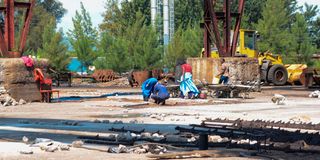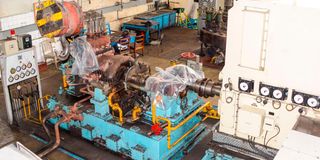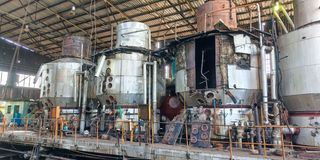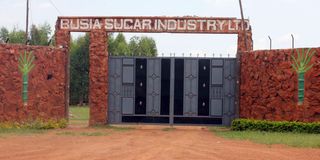
Ongoing fabrication and construction works at Muhoroni Sugar Factory on June 13, 2025, as preparations intensify for its reopening under the new leaseholder, Kipchimchim Group of Companies.
Days after the symbolic ‘white smoke’ rose from Nairobi as the government announced the leasing of four state-owned sugar factories to private millers, miles away in Migori county a literal white smoke, like the one that whirled from the Sistine Chapel in the Vatican to symbolise election of a new Pope, billowed from one of the chimneys of South Nyanza Sugar Factory (Sony Sugar).
Apart from Sony, other State-owned sugar millers, including Muhoroni, Chemelil and Nzoia had stopped crushing sugarcane as farmers and workers went for months without being paid.
Farmers in the so-called sugar belt would nervously shoot up glances towards the skies, just as they do when there is no rain, in a desperate search for some smoke.
But with the leasing of the four derelict state-owned sugar factories, there was hope. Smoke came out of Sony Sugar factory.
Days after new investors took over the operation of these millers, a team from the Nation Media Group traversed the breadth of the sugar belt region, from the slopes of Mount Elgon to the shores of Lake Victoria.
But after seven days, we realised that the long-awaited smoke is not as white as the one from the Sistine Chapel. We would learn that the plumes of hope from the boilers of these factories are supposed to be greyish-white.
Only the relentless billow of this greyish-white smoke from the chimneys of the four factories will bring back the lost grin on the weary faces of the residents of the sugar belt region.

Obsolete machinery at Chemelil Sugar Factory, on June 17, 2025. Once a key player in Kenya’s sugar belt, the factory is now under new management by Kibos Sugar Company
For more than two weeks, we hunted for this elusive greyish-white smoke associated with the proper milling of sugarcane in the four factories.
We doggedly searched for this smoke, not just physically from the chimneys of the four factories, but also across time from volumes of official reports and interviews with authorities in the sector, including farmers, CEOs, factory managers, cane growers, CEOs, traders, and ethanol manufacturers.
Recently, there has been no smoke at all. Even worse, whenever the boilers have been switched on, it is black smoke that has ominously rushed into the skies. Black smoke is a sign of inefficiency.
A day before we visited, the new investor at Sony, Busia Sugar, had fired up one of the factory's functional boilers. Tongues of flame in the boiler licked up the dry residue that is left after extraction of juice from sugarcane, or bagasse (cane fibres), turning them into puffs of white smoke.
This white smoke inflamed a wave of enthusiasm along the supply chain and the nearby Awendo town. The refrigerator in the cafeteria might not have had a cold soda for the afternoon heat, but workers chatted animatedly while helping themselves to modest servings of chai and chapati or nyoyo (a mix of maize and beans), in anticipation of the payment of their arrears by the government.
Months of unpaid labour, a source of friction with the management as captured on various noticeboards, had been forgotten in a fit of expectation.
The government had promised to pay the arrears to all the workers in the four sugar factories, amounting to Sh5.23 billion, in six months.
Sh1.71 billion arrears
President William Ruto's administration has also promised to pay farmers arrears of Sh1.71 billion. In total, the government has promised to absorb the millers’ liabilities amounting to Sh128 billion, including loans and taxes.
This will give new investors some breathing space to take up the operations of the mills without any major encumbrance. Their only role is to fire up the machines, most of which are aged, and produce enough sugar to pay farmers and workers.
In return for the companies’ assets, the government also expects to be paid for the use of the thousands of acres for the nuclear estates and get a share of the revenues generated from the sugar that will be produced by these sugar mills.
At Sony, prime movers brimming with sugarcane hankered towards the weighbridge of the factory as the company started receiving cane from out-growers, or independent farmers.
The harvested crop would then be offloaded into a sugarcane yard. But it could not get past one of the mills for the extraction of juice containing sucrose.
Sugar production depends on the extent to which a farmer grows a sucrose-rich sugarcane and the factory saps it from the crop.
Ideally, the farmer should grow a crop with sucrose content of between 13 per cent and 14 per cent, while the miller should recover at least 98 per cent of this sweetness.
As we made the turn from the main road onto the road to the factory, a truck carrying sugarcane lumbered ahead of us, behind it were flashed these words: You have to sweat, to get the sweet.
To grow cane to maturity, farmers have patiently tended to the crop for as long as 24 months. And for 24 months, farmers have cleared, dug, removed weeds, applied fertiliser, stood vigil against thieves, and transported the crop from the farm to the factory only for their sweat to be lost in a black smoke of inefficiency or the eerie silence of impotence.
However, at Sony on this day, the smoke was harmlessly white. So, unlike the smoke from the Sistine Chapel, which is received warmly by over a billion Catholics, the white smoke from Sony’s smokestack was received with reluctant optimism by the millions who depend on the factory.

Obsolete facilities and stalled machinery at Chemelil Sugar Factory, on June 17, 2025.
The machines were humming, alright, but not a single crystal of sugar was being churned out.
You only had to get inside the factory to realise that the white smoke from the smokestacks of the sugar factory did not signal a breakthrough. At every other stage of the milling process, we were met with laborious explanations that boiled down into a ‘mechanical breakdown.’ This meant that workers at the sugar processing section were idle.
No sugar was being produced. Not just yet.
Sony's incoming Managing Director, Jane Pamela Odhiambo, popularly known as JP, told us they had to bypass one of the mills due to a faulty electric motor.
“Remember, the mill had been closed for two months. So, when it opens, you encounter a few teething problems,” said the factory manager of Sony Sugar.
When sugarcane is being milled properly, with the miller recovering 98 per cent of the sucrose, a small fraction escapes to the boiler with the bagasse. Hence the greyish-white smoke.
Sony—which has been leased to Busia Sugar—had shut down for two and a half months.
The same was true of the mills in the other state-owned factories in Bungoma, Migori and Kisumu counties, which had gone silent, leaving behind a trail of disillusionment.
Because the factories lacked funds, farmers sold their sugarcane to the closest private millers, and where they could not due to the high cost of transport, they opted to leave their crops in the fields. Some of the farmers abandoned the trade altogether and switched to other, equally unprofitable cash crops like maize.
This anguish—which has been aggravated by years of mismanagement, wanton looting, and political interference—spreads to the other three state-owned sugar companies that have also been leased.
When he visited Nzoia Sugar earlier this year, President William Ruto was forthright on how he thought the sugar companies had to be run.
At the holding room before proceeding to tour the factory and address the wananchi, Dr Ruto told the assembled MPs that as agriculture minister in Mwai Kibaki's government, as the Deputy President under Uhuru Kenyatta and now as President, there was a familiar disturbing pattern where every two years sugar factories were being bailed out using taxpayer's money.
"Every year, farmers bring cane, it is processed, and it hits supermarket shelves. Then farmers never get paid, factory workers don't get paid, and the government, instead of getting dividends, it uses taxpayers' money to bail out factories," said Dr Ruto.
"Good people, I will lease these factories for 25 years and farmers will get paid on time, factory workers will get paid and the government and farmers will be getting dividends and bonuses just like the tea farming areas," he added.
President Ruto made good his promise, though the leases were for 30 years instead of 25 years.
Kisumu County’s Muhoroni and Chemelil have been leased to West Valley and Kibos Sugar, respectively. Nzoia Sugar in Bungoma County will be managed and operated by Rai family’s West Kenya.
Critics — of which politicians in the areas with the affected mills have been the loudest — are not convinced this leasing programme is the panacea to the sugar industry’s woes.
Kenya’s dalliance with privatisation, they have argued, has been disastrous. There has been a feeling that privatisation has catapulted a few, well-connected individuals into the billionaire club, without benefiting the entire economy, a phenomenon known as crony capitalism.
It will not be the first time the management of state-owned sugar factories has been entrusted to private investors, especially foreign multinational corporations. Before Kenya gained independence from the British, there was minimal government involvement in either production or marketing of sugar.
Just as few imagined the sun would finally set on the British Empire by the time the region's first mill was established in Kibos in the former Nyanza Province in 1922, no one thought Miwani Sugar Company and its vast tracts of land could be a stark reminder of how opaque state-driven privatisation can leave a bitter taste in the mouths of farmers.
After independence, and with the two Asian-owned sugar factories in Miwani, Kisumu District and Ramisi, Kwale District, not keeping up with the increased domestic requirement for sugar, the government found it wise to plunge into the sugar industry.
The management of the new sugar factories that the state started would be left to foreign multinational corporations, but the government policies would remain dominant in the operations of the firms.
The central planning experiment, which initially included appointing a board of directors in the companies to make policy decisions, as well as the determination of prices, right from what was paid to farmers and what was paid by consumers, was disastrous.
The state would loosen its grip on the industry, and drop controls on prices, but ownership of most of the factories would remain under its control.
Efforts to bring in the efficiency of the private sector were not working either.
Sixty years later, the post-independent government would take over Miwani Sugar, enter into a public-private deal with Ketan Somaia, a charming and smooth-talking Kisumu-based entrepreneur who acquired a 51 per cent stake in the sugar company allegedly without paying a dime and later flee to Dubai.
He left behind debts amounting to Sh2 billion to creditors and Sh500 million unpaid dues to farmers, and set off a bruising battle that has ensured the giant miller remains silent for decades.
Mehta Group International, which had been tasked with managing Sony and Muhoroni, was forced to leave in a huff and would never attempt re-entry even when given an opportunity years later.
Going the listing way has also not helped. Mumias Sugar, which was listed on the Nairobi Securities Exchange (NSE) after the government offloaded 80 per cent of its shares to the public in 2001, plunged into debt, and its machines would start humming faintly and finally go silent in 2017. It was finally placed under receivership on September 20, 2019, by KCB Kenya for unpaid debts.
A protracted legal battle over leasing plans ensued after the country’s largest miller was placed under receivership. KCB, through its appointed receiver manager, settled on Uganda’s Sarrai Group, by-passing other bigwigs that had shown interest in the miller, including West Kenya and steel magnate Narendra Raval.
Mr Sarbjit Singh Rai, who owns Sarrai Group, has been cleared to run the mill, ending months of bruising battle with his brother-turned-rival, Jaswant Rai, the chairperson of Rai Group, the ultimate holding company for West Kenya Sugar.
Political interests
Politicisation of the management of state-owned sugar factories, said Pamela Odhiambo has particularly been pernicious, with the board forced to address political interests rather than the firm’s interest when making a decision.
“The company was seen as belonging to the community,” said JP. Decision-making and procurement, including buying a simple spare part in case of a breakdown in the mill, was hobbled by government bureaucracy, explained JP.
Because the state stopped guaranteeing millers, most of the factories and plants went for years without the critical annual maintenance meant to help the mills squeeze as much sucrose from sugarcane as possible.
The last major maintenance for Nzoia was undertaken in 2015.
“You can imagine if a car can go beyond the time that is supposed to be serviced, then there is a problem,” said Ezron Kotut, the managing director for Nzoia Sugar.
“Because that car will not move. It will go slowly, and eventually, there will be an engine failure or something of the sort,” added Kotut.
Muhoroni sugar, the country’s first sugar miller, which has been under receivership before it was leased out, is a spectacle of obsolescence.

Years of abandonment had created a conducive environment for plants to grow on its roofs. The holes on the roof are so huge that it is said workers operated with umbrellas when it rained.
When we got to the factory, there was no smoke. The mills were dead silent. The only sounds that could be heard were the gong of the sledgehammer and the crackle of the welding machines as repairs went on in earnest.
The new private investor at Muhoroni wants to start crushing sugarcane within two months to unlock financing.
The factory’s spare parts, some of which were procured in 1964 when the miller was started, can’t be easily found as they have become obsolete, the new managing director of Gabriel Nyangweso said.
There was also no sight of smoke coming out of the chimneys of Nzoia Sugar, Bungoma County. The new investor, West Kenya, is doing a total overhaul of the factory for 60 days before it starts accepting sugarcane from farmers.
So inefficient was the company that when operating, it crushed 20 tonnes of sugarcane in a day to produce a tonne of sugar. That was the same with Muhoroni.
West Kenya owns Naitiri in Bungoma County, Kabras in Kakamega and Olepito in Busia County.
In Homa Bay County, the Rai family, through Sukari Industries, owns Ndhiwa Sugar in Homa Bay. West Kenya and Sukari Industries fall under Rai Sukari, a part of the Rai Group, which has a total of 23 companies.
While at Nzoia, an employee of West Kenya points us to a mountain of sugarcane at the miller’s cane yard. He informs us that the whole of that harvest, worth Sh10 million, will be thrown away as it has already lost its sucrose content, which should have been extracted within four days of being harvested.
Yet, questions remain unanswered. What exactly is contained in these lease agreements, and why aren’t they public?
After the lapse of the leases in 30 years, will the sugar brands—Nzoia, Mumias, Sony and Muhoroni—still be there?
How much are the millers paying for the land leases?
And where, between the farm producing sucrose and the firm extracting this sweetness, is the problem?
This is not only a sad tale of Kenya’s sugar industry, it is also the story of a resilient people whose hopes have continued to burn bright despite spates of betrayals by self-serving politicians and profiteers.
This is the story of a cash crop whose sweetness has increased billions in the accounts of a few but left a bitter taste in the mouths of millions of residents in western Kenya.
Tomorrow: Inside the sad plight of the Kenyan sugar farmer








